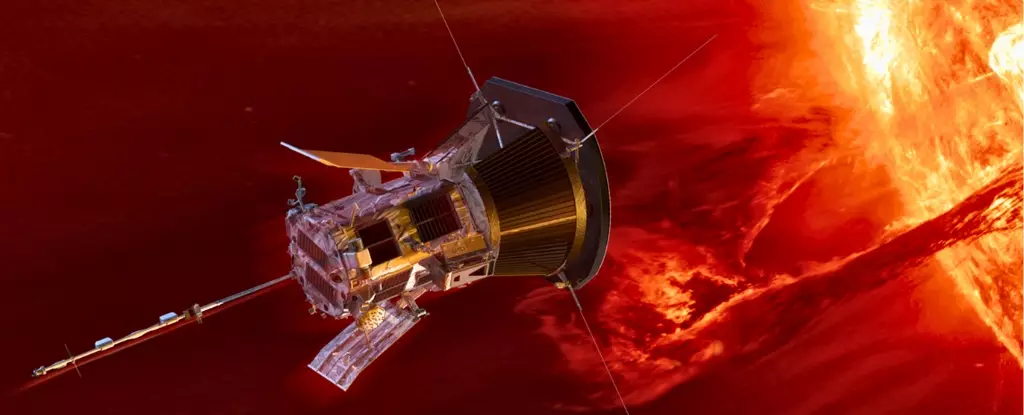Since its launch in August 2018, NASA’s Parker Solar Probe (PSP) has embarked on a groundbreaking expedition to the outer corona of the Sun, redefining our understanding of our nearest star. This monumental journey, marked by multiple gravity-assist maneuvers with Venus, has enabled the probe to set distance records, becoming the closest human-made object to the Sun. It is not merely a mission of exploration; it also holds the promise of profound revelations about solar dynamics that affect not only our space environment but also the technology we depend on here on Earth.
On October 29, 2018, the Parker Solar Probe achieved a remarkable milestone by breaking the Helios 2’s previous distance record, subsequently making several close approaches to the Sun in the years that followed. It reached its closest point to the Sun on December 24, 2024, coming within a mere 6 million kilometers of the surface — about 0.04 astronomical units (AU) from the Sun. This unprecedented closeness allows the probe to “touch” the solar atmosphere, delving into phenomena previously veiled from human scrutiny.
Traveling at an astounding speed of approximately 692,000 kilometers per hour (430,000 miles per hour), the Parker Solar Probe became the fastest human-made object ever. At this velocity, it approaches 0.064% the speed of light, placing it well within the realm of record-breaking performances in human engineering. Following its perilous passes, the probe has successfully sent back data confirming its safe operation, affirming its vigorous capacity to withstand extreme conditions.
A critical aspect of the Parker Solar Probe’s design is its advanced shielding technology. To withstand the extreme temperatures of the solar corona, which can reach up to 1,425 degrees Celsius (2,600 degrees Fahrenheit), the probe is equipped with a specialized carbon foam shield. This innovation not only protects the instruments aboard but also ensures that they remain at a stable, operational temperature, allowing scientists to capture data in the harshest environment imaginable.
This engineering prowess exemplifies a monumental achievement in scientific exploration — an accomplishment that places humanity in direct interaction with a star, revealing secrets of both solar dynamics and broader astrophysical processes.
One of the prime objectives of the Parker Solar Probe is to study solar wind and its acceleration mechanisms, which influence space weather throughout the solar system. So far, the probe has made significant discoveries, including understanding the structure of the corona, which features unexpected spikes and valleys, and the origin of switchbacks in the solar wind.
The probe’s encounters with coronal mass ejections (CMEs) have also provided unparalleled data about these explosive events that can influence technology on Earth, affecting communications and satellite operations. As the probe continues its mission, data collected will have far-reaching implications for both space and Earth sciences.
Interestingly, the Parker Solar Probe is also expanding our knowledge beyond the immediate effects of solar activity. It has captured invaluable data on Venus, volunteering a trove of images during its numerous gravity assists and documenting the planet’s radio emissions. Furthermore, the probe provided the first complete image of Venus’ orbital dust ring and insights into the interactions between solar wind and terrestrial phenomena. This multifaceted approach has firmly positioned the Parker Solar Probe not only as a solar research instrument but as a vital resource for understanding the behaviors of neighboring celestial bodies.
As the Parker Solar Probe forges ahead with its upcoming solar passes in March and June 2025, the scientific community eagerly anticipates the wealth of information it will bring back. The data amassed during these intimate encounters with the Sun will yield insights into solar processes that govern our solar system’s environment.
Nour Rawafi, the project scientist for the mission, expressed the significance of this undertaking: “The Parker Solar Probe is braving one of the most extreme environments in space and exceeding all expectations.” This mission marks the dawn of a new era in space exploration, bridging humanity’s thirst for knowledge of the cosmos with the practical implications of solar science.
Through its remarkable journey, the Parker Solar Probe exemplifies the spirit of exploration and innovation that drives humanity’s quest for knowledge. By pushing the boundaries of engineering and scientific inquiry, it provides us with profound insights into the Sun’s mysteries and their integral role in the universe. As data streams in and new discoveries unfold, the legacy of this mission will undoubtedly continue to shape our understanding of the solar system and our place within it.


Leave a Reply